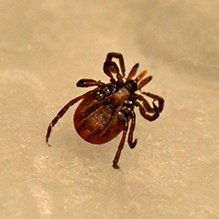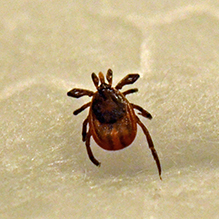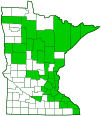blacklegged tick
(Ixodes scapularis)
Conservation • Description • Habitat • Biology • Distribution • Taxonomy
Conservation Status |
|
|||||||
| IUCN Red List | not listed |
|||||||
| NatureServe | not listed |
|||||||
| Minnesota | not listed |
|||||||
Description |
||
|
||
Size |
||
Nymph: 1 ⁄16″ to 3 ⁄16″(1-2 mm) Adult: about ⅛″ (3 mm) |
||
Web |
||
|
||
Similar Species |
||
Habitat and Hosts |
||
Hardwood forests, wooded or brushy areas. Mice and other small mammals, birds, dogs, raccoons, deer, and humans |
||
Biology |
||
Season |
||
February through November, peaking Mid-May through mid-July |
||
Behavior |
||
|
||
Life Cycle |
||
|
||
Food |
||
Blacklegged ticks have three blood meals. Meal 1, larva: mostly white-footed mouse (Peromyscus leucopus) but also other small mammals and ground-feeding birds Meal 2, nymph: mostly small mammals and birds, but also dogs and humans Meal 3, adult: mostly whitetail deer (Odocoileus virginianus), but also dogs, cats, horses, and humans |
||
Distribution |
||||
|
Sources |
|||
| 5/24/2022 | ||||
Occurrence |
||||
Common and abundant |
||||
Taxonomy |
|||
| Class | Arachnida (Arachnids) | ||
| Subclass | Acari (mites and ticks) | ||
| Superorder | Parasitiformes | ||
Order |
Ixodida (ticks) | ||
Superfamily |
Ixodoidea | ||
Family |
Ixodidae (hardbacked ticks) | ||
Genus |
Ixodes | ||
Synonyms |
|||
|
|||
Common Names |
|||
bear tick black-legged tick blacklegged tick deer tick shoulder tick |
|||
Disease vector
Almost all cases of Lyme disease in humans are caused by blacklegged tick nymphs. They are about the size of a poppy seed and therefore not noticed until they are fully engorged. By that time they have already transferred Lyme disease to their host.
Visitor Photos |
|||||
Share your photo of this arachnid. |
|||||
| This button not working for you? Simply email us at info@MinnesotaSeasons.com. Attach one or more photos and, if you like, a caption. |
|||||
Christa Rittberg |
|||||
 |
 |
||||
MinnesotaSeasons.com Photos |
|||||
|
|||||

Slideshows |
||
| Ixodes scapularis Audiopedia |
||
About
Published on Nov 30, 2014 Ixodes scapularis is commonly known as the deer tick or blacklegged tick (although some people reserve the latter term for Ixodes pacificus, which is found on the West Coast of the USA), and in some parts of the USA as the bear tick. It is a hard-bodied tick (family Ixodidae) of the eastern and northern Midwestern United States. It is a vector for several diseases of animals, including humans (Lyme disease, babesiosis, anaplasmosis, etc.) and is known as the deer tick owing to its habit of parasitizing the white-tailed deer. It is also known to parasitize mice, lizards, migratory birds, etc. especially while the tick is in the larva or nymph stage. This video is targeted to blind users. Attribution: |
||

Visitor Videos |
|||
Share your video of this insect. |
|||
| This button not working for you? Simply email us at info@MinnesotaSeasons.com. Attach a video, a YouTube link, or a cloud storage link. |
|||
Other Videos |
|||
| How Do Deer Ticks Become Infected With Lyme Disease? TickEncounter Resource Center |
|||
About
Uploaded on Aug 17, 2010 This video will demonstrate why the Lyme disease "life cycle clock" starts ticking in August, when blood hungry larvae feed on infected rodents. |
|||
| Tick Identification MainePublicHealth |
|||
About
Published on Jul 2, 2015 We hope to help educate folks on how to identify the differences between a Deer ticks (Ixodes scapularis) and Dog ticks (Dermacentor variabilis). The most identifiable difference is the coloring on the ticks "scutum" or the shield behind the tick's head. Deer Ticks Dog Ticks Check our UMaine's tick removal video below! https://youtu.be/pz-r55wRw8c Thanks for watching! |
|||
| Female Black-legged or Deer Tick (Ixodidae: Ixodes scapularis) Carl Barrentine |
|||
About
Published on May 10, 2013 Photographed while it crawled up the left leg of my faded Levi blue jeans, when I was out looking for more photographic fauna near Fisher, Minnesota (10 May 2013). Go here to learn more about this species: http://www.extension.umn.edu/distribution/naturalresources/M1275.html |
|||
| How to remove Ticks, Wood or Deer tick. Pull off slowly prevent lyme disease WillCFish Fishing TipsandTricks |
|||
About
Published on Jun 15, 2015 Easy removal of Wood Ticks and Deer ticks. Watch out for a circle of infection which means Lymes disease could be occurring. Angling for Free Fishing Videos? Here is a video on Fishing Tips and Tricks, I do video on many species such as Catfish, Walleye, Muskie, Northern, Panfish, Salmon to include most freshwater and some saltwater fish. Information good from Fishing Pro to Novice angler will like this instruction where you can Discover Fishing when you are on the hunt for big fish. I will be talking about Fish, Fishing, Outdoors, lures, boats, motors, rods, reels, Bass, Boating, and wildlife. |
|||
| Dangerous Deer Ticks National Geographic |
|||
About
Published on Oct 1, 2012 You don't want this tick anywhere near you. It was near Lyme, Connecticut, that deer ticks transmitted what we now know as Lyme Disease. |
|||

Visitor Sightings |
|||||
Report a sighting of this insect. |
|||||
| This button not working for you? Simply email us at info@MinnesotaSeasons.com. Be sure to include a location. |
|||||
|
|||||
MinnesotaSeasons.com Sightings |
|||||

Last Updated:
